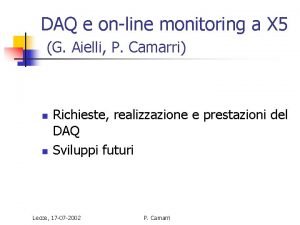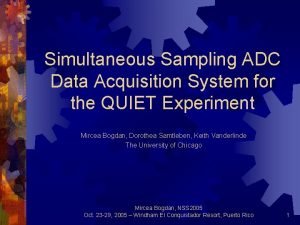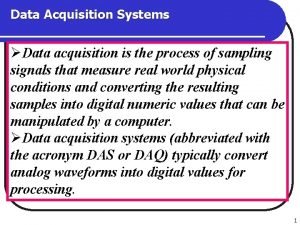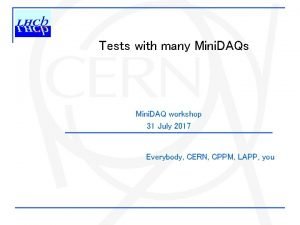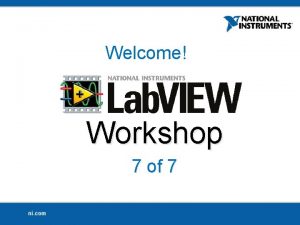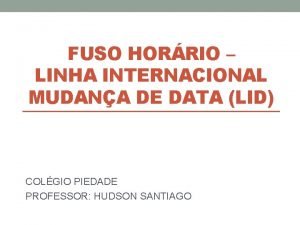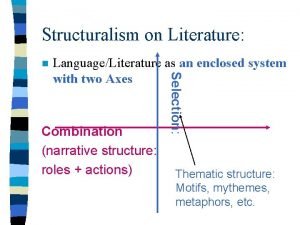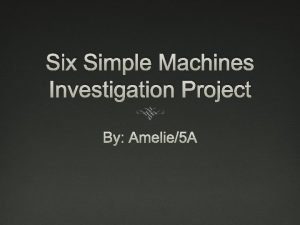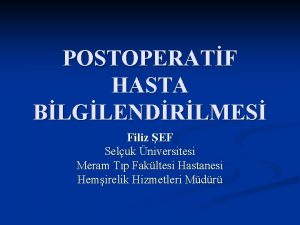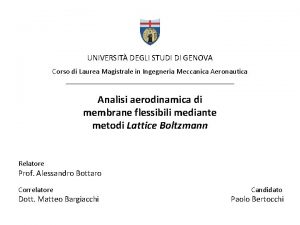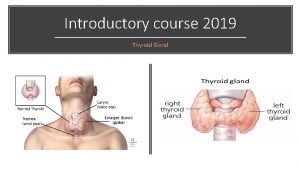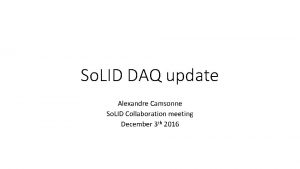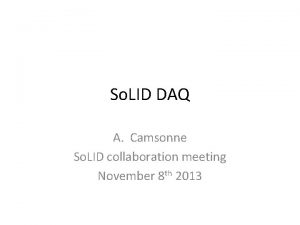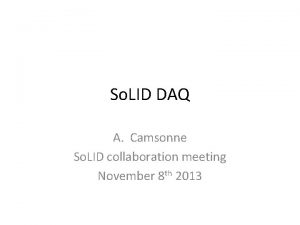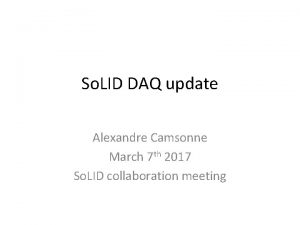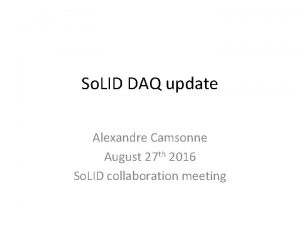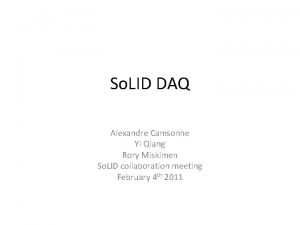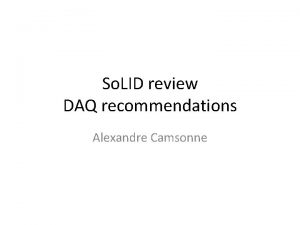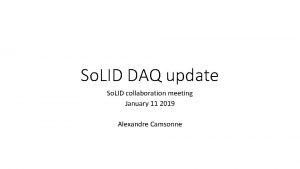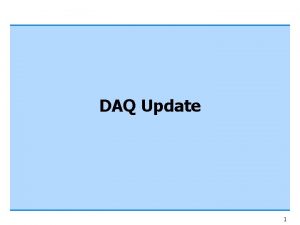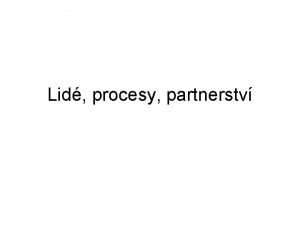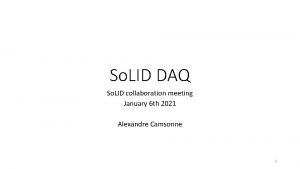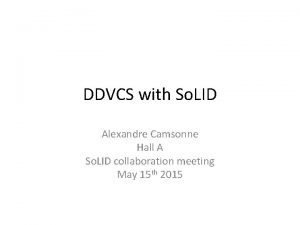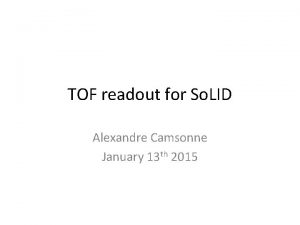So LID DAQ Update A Camsonne R Miskimen


















- Slides: 18

So. LID DAQ Update A. Camsonne, R. Miskimen, Y. Qiang So. LID Collaboration Meeting Dec 15 th 2012

Overview 2 ØDAQ Setup ØEvent Sizes and Data Rates ØAPV 25 Test Stand ØFuture Plan So. LID DAQ 12/25/2021

PVDIS DAQ Setup Detector Module # of Channels Calorimeter (CAL) FADC 114 × 30 3 # of Modules 8 x 30 Gas Cherenkov (GC) FADC 9 × 30 GEM APV 25 -VME 4800 × 30 5 x 30 PVDIS VXS Crate × 30 CPU CTP FADC × 8 APV 25 × 5 SD TI Crate Trigger Processor (CTP) Trigger Interface (TI) Signal Distribution (SD) Ø Trigger rate for each crate: 20 k. Hz So. LID DAQ 12/25/2021

SIDIS DAQ Channel/Module Counts Detector Module # of Channels # of Modules Forward Calorimeter (FC) FADC 1920 120 Large-angle Calorimeter (LC) FADC 960 60 Light Gas Cherenkov (GC) FADC 270 20 Heavy Gas Cherenkov (HG) FADC 270 20 GEM Pad Readout (GP)* FADC 150(L)/270(F) 10/20 GEM AVP 25 -VME 180 k 180 MRPC VME 7500 60 * Original scintillator bars in forward will be replaced by GEM pad readout if possible So. LID DAQ 12/25/2021 4

SIDIS DAQ/Trigger Setup Global Trigger VXS Crate CPU SSP x 3 GTP TS GEM Tracker VXS Crate x 10 TD x 4 CPU CTP SD CPU CTP MRPC x 4 SD TI Optional TDC Crates for LC TI LC Timing VXS Crate x 1 CPU Forward VXS Crate x 15 FADC x 8 (FC) + x 4 (GC+HG+GP) APV 25 x 18 Trigger Forming Trigger Distribution Large-Angle VXS Crate x 5 FADC x 12(LC) + x 2 (GEM Pad) 5 V 1190 x 8 SD TI LC Timing VME Crate x 3 SD TI CPU Ø e−@Large: Discriminator x 20 LC & GP 13 k. Hz Ø e−@Forward: FC(high) & GC 65 k. Hz Ø π@Forward: FC(low) & MRPC & GP 15 MHz Ø Coincidence: e− & π 60 k. Hz@50 ns * Coincidence rate scales with the square of luminosity So. LID DAQ Crate Trigger Processor (CTP) Sub-System Processor (SSP) Global Trigger Processor (GTP) Trigger Supervisor (TS) Trigger Interface/Distribution(TI/D) Signal Distribution (SD) 12/25/2021

J/φ DAQ Setup 6 Ø Same hardware as SIDIS Ø Different Trigger Logic: e−(scattered): q Lepton@Large-angle: q Lepton@Forward: q Triple Coincidence: q FC(medium) & GC LC & GP FC(high) & GC e− & l+ & l − Ø Trigger Rate: q 15 k. Hz for triple coincidence with 100 ns window So. LID DAQ 12/25/2021

Total DAQ Hardware 7 Module PVDIS SIDIS Total Unit Cost VXS Crate 30 31 31 $11, 500 $356, 500 VME CPU 30 31 31 $3, 400 $105, 400 CTP 30 20 30 $5, 000 $150, 000 SD 30 30 30 $2, 500 $75, 000 FADC 240 250 $4, 500 $1, 125, 000 AVP 25 -VME 150 180 TI 30 30 30 $3, 000 $90, 000 GTP 1 1 $5, 000 TS 1 1 $3, 500 TD 4 4 $3, 000 $12, 000 MRPC-VME 60 60 Total $1, 842, 000 $1, 872, 400 UVa/China $1, 922, 400 * Optional SIDIS Large-angle Timing: $292, 980 So. LID DAQ 12/25/2021

PVDIS Event Size and Data Rate Ø GEM Rates per Sector (25 ns window, LH 2, 11 Ge. V) Raw w/ Threshold Deconvolution Hits 1182 555 53 Occupancy 25% 12% 1. 1% q o Ø Event Size per Sector (50 ns window, 11 Ge. V) Detector Rate Hits Type Data Size per hit GEM (25 ns) 47 GHz 555 (threshold) 3 x. Samples, Time, Position 12 Bytes Calorimetry 5 MHz 1 Energy, Time, Position 8 Bytes x 2 (PS/SH) Gas Cher 10 k. Hz 1 Energy, Time, Position 8 Bytes x 9 (Split) Total 7 k. B Ø Data Rate per Sector: q 20 k. Hz x 7 k. B = 140 MB/s So. LID DAQ 12/25/2021 8

Comments on PVDIS 9 Ø Rates per sector are manageable. Ø High occupancy in GEM: 3 samples are absolutely needed. Deconvolution helps, but might be safer to send non de-convoluted signal for offline treatment as long as bandwidth allows. Ø Need two Ethernet links for each crate: ~ 200 MB/s. Ø Test convolution behavior at very high rate. Ø Strategy for online data reduction before recording: Trace back from shower to define region of interest q PID cut q Online coarse tracking q So. LID DAQ 12/25/2021

SIDIS Event Size 10 Ø GEM Rates (25 ns window, 11 Ge. V) Raw w/ Threshold Deconvolution Proposal Hits 5826 1358 122 110 Occupancy 3. 2% 0. 8% 0. 1% Ø Event Size (50 ns window, 11 Ge. V) Detector Rate Hits Type Data Size per hit GEM (25 ns) 4. 9 GHz 122 (deconv. ) Integral, Time, Position 8 Bytes LC 120 k. Hz 1 Energy, Time, Position 8 Bytes x 2 (PS/SH) FC 200 MHz 10 Energy, Time, Position 8 Bytes x 2 (PS/SH) GC 40 MHz 3 Energy, Time, Position 8 Bytes x 9 (split) HG 60 MHz 4 Energy, Time, Position 8 Bytes x 9 (split) MRPC 850 MHz 45 Time, Position 6 Bytes GEM Pad 300 MHz 15 Energy, Time, Position 8 Bytes Total 2. 1 k. B* * 17 k. B if use only apply threshold on GEM Readout with 3 sample mode So. LID DAQ 12/25/2021

SIDIS Data Rates 11 Ø 60 k. Hz Trigger Rate: Crate Name # of Crate Detectors Total Data Rate per Crate GEM 10 GEM 59 MB/s 5. 9 MB/s* Large-angle 5 LC GEM Pad 1. 2 MB/s 0. 24 MB/s 15 FC GC HG GEM Pad MRPC 63 MB/s 4. 2 MB/s Forward * 98 MB/s is only apply threshold w/ 3 sample mode So. LID DAQ 12/25/2021

Comments on SIDIS 12 Ø Deconvoluted GEM rate consistent with proposal. Ø GEM occupancy is low, 1 sample may be OK for less noisy environment, but cannot be used if deconvolution method used. Ø Data rates well under control. Ø Still need to test GEM pad readout. So. LID DAQ 12/25/2021

APV 25 GEM Readout 13 Ø Switch Capacitor Array ASICs q q 128 channels Sample rate: 40 MHz Buffer length: 192 samples, 4. 8 us Look back: 160 samples, 4 us Ø Readout Time/Max Readout Rate: q q q T_APV = 141 x Nsample / 40 MHz 1 sample mode: 3. 5 us, 280 k. Hz 3 sample mode: 10. 6 us, 90 k. Hz Ø PVDIS: 20 k. Hz q 3 sample mode is feasible and needed Ø SIDIS: 60 k. Hz q q 1 sample mode if using a global GEM trigger, deconvolution cannot be applied 3 sample mode if using crate dependent trigger, taking advantage of low occupancy So. LID DAQ 12/25/2021

APV 25 Test Stand at UVa/JLab Ø University of Virginia: Running VME system using multi-purpose degitizer (MPD) modules with CAEN controller. q SRS DAQ system. q Some work ongoing on electronic noise q Plan to move to JLab q Ø Jefferson Lab Test setup deployed q Development of readout with Intel VME CPU and CODA q Should be able to start testing in 2013 q Ø Evaluation of electronics performance by 2013 So. LID DAQ 12/25/2021 14

Future Plan 15 Ø Continue work on GEM readout: Study threshold and deconvolution efficiency q Data reduction q Ø Trigger Simulation (Software): On top of existing physics simulation q Find optimal trigger logic q o Information needed: Energy sum? Hit pattern? o Formula to process information o Bandwidth usage: within limit? o Minimize background rate o Maximum efficiency for real events, less bias q Get more reliable trigger rates So. LID DAQ 12/25/2021

Future Plan (continued. ) 16 Ø Bench Top Tests of Trigger Electronics: Setup a small scale DAQ system q No detector really needed as FADC can replay “predefined” waveforms q Test the capability of the processing power of various modules: CTP, SSP, GTP q Ø Possible Resources: Jlab: Pipeline electronics q UVa: GEM related q UMass: Testing hardware q Duke: Min Huang q So. LID DAQ 12/25/2021

BACKUP So. LID DAQ 12/25/2021

Comments on GEM Readout 18 Ø No show stopper Ø Realistic effect of background Ø Need to define threshold from MIP signal Ø Study hit/tracking efficiency as function of threshold Ø Start work on data reduction So. LID DAQ 12/25/2021 18
 Immediate update and deferred update in dbms
Immediate update and deferred update in dbms Vme
Vme Simultaneous sampling daq
Simultaneous sampling daq Digital data acquisition system block diagram
Digital data acquisition system block diagram Clark county daq
Clark county daq Mini daq
Mini daq Daq assistant express vi download
Daq assistant express vi download ʧes
ʧes Hexaflexercise
Hexaflexercise Lid linha internacional de data
Lid linha internacional de data When the low heavy sky weighs like a lid
When the low heavy sky weighs like a lid Most important kinds of mathematical statements
Most important kinds of mathematical statements Inclined plane wrapped around a pole
Inclined plane wrapped around a pole Lid care solüsyon
Lid care solüsyon Kitchen matching game
Kitchen matching game Flip your lid
Flip your lid Trojí lid
Trojí lid Equazione di boltzmann
Equazione di boltzmann Ocular sign
Ocular sign

